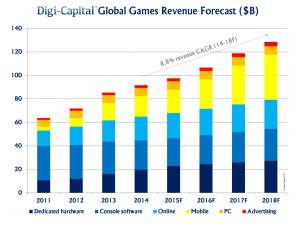Our Friends at Digi-Capital have released their latest analysis of market trends, this time regarding the games industry. The Headline information is that 2014 saw a record $24B of game company exits across acquisitions and IPO’s, with more than half of this value being driven by mobile. $15B of the $24B was from acquisitions, with 5 ‘megadeals’ being responsible for $8.1B of this. The other $9B came from IPO’s, which was dominated by Asia. These statistics could be seen as representative of a bubble, but the analysis from Digi-Capital explains why these statistics have a more subtle meaning.
Digi-Capital hark back to an earlier report they prepared at the beginning of 2014, where they predicted that the games software market would reach $100B by the end of 2017. Having re-analysed the data from last year, they have revised this to happen at the end of 2018 instead. This is due to the fact that only mobile gaming is showing strong double digit growth, with the possibility that virtual reality could also become a breakout. This leaves their overall growth forecast for games software/hardware at 8.8%. While this is of course a healthy number, Digi-Capital point out that markets with single digit growth cannot be described as bubbles, as in these conditions “a rising tide no longer lifts all boats”. In this instance, not just any company can be guaranteed to grow exponentially on the crest of a wave, and the quality of the product and company is far more important.
Hit hardest by this single digit growth are the mid-tier games companies, according to the report. Big corporate firms with hit IP’s (Intellectual properties), user scale and cash flow are able to invest in infrastructure and marketing to compete in a stable growth market. Smaller independent firms may not have a hit IP yet, or the advantages that come from being a big firm, but their costs are far lower, allowing them too to compete. It’s the mid-tier firms that Digi-Capital warn could be in for a tough time. They may not have the hit IP’s yet, or the advantages from being a large-scale company, but they still have the costs associated with infrastructure and marketing. It isn’t the end for them by any means, as they of course still have the capability to produce a hit IP, but they seem to be in the most vulnerable position over the next few years.
A further challenge for mid-tier companies detailed in the report is the nature of acquisitions and investments in a stable growth market. The big corporate buyers are already managing their own cost bases, and so acquiring whole teams is low on their list of priorities. It is exceedingly difficult to overtake big companies when you are medium sized, and the investment amount of $1.5b in 2014, while not insignificant, is still 25% lower than it was in 2011. This all adds up to difficult years up ahead for non-savvy mid-tier games companies.
This analysis, while not overly pessimistic, means that companies have to be smarter to see success. KamaGames, who we have worked with, have a portfolio that currently reaches 70M users worldwide. They have now partnered with Manchester United, and will launch special edition s of their games with a Manchester United crest, imagery and theme. As they are one of the most supported teams worldwide, this opens up an opportunity to significantly grow their user base. Another way to keep up growth and attract attention is to focus on the highest growth area of the sector. Both KamaGames and another of our clients, Joybits, focus on the mobile side, as this is the only area with double digit growth. As detailed in a previous Forsyth Group blog, Games are the app segment with most frequent use after downloading, so there is scope for this area to continue to grow.
The report ends with a warning that until there is a new wave of innovation that can accelerate market growth, consolidation is the key. This isn’t necessarily bad news though, as it means that quality is more prized than quick, unwarranted growth.
